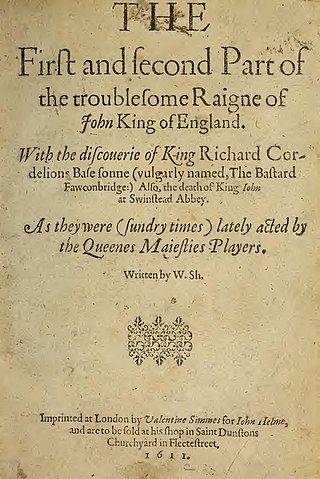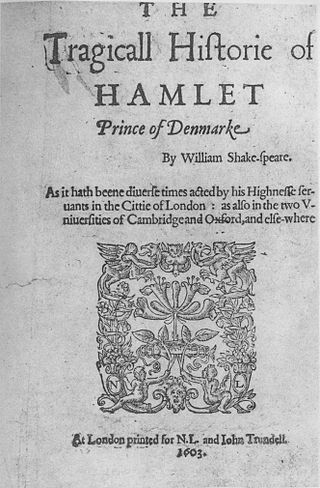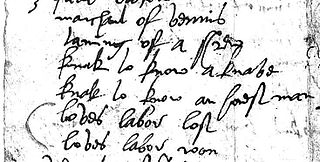Thomas Kyd was an English playwright, the author of The Spanish Tragedy, and one of the most important figures in the development of Elizabethan drama.

The earliest texts of William Shakespeare's works were published during the 16th and 17th centuries in quarto or folio format. Folios are large, tall volumes; quartos are smaller, roughly half the size. The publications of the latter are usually abbreviated to Q1, Q2, etc., where the letter stands for "quarto" and the number for the first, second, or third edition published.

King Leir is an anonymous Elizabethan play about the life of the ancient Brythonic king Leir of Britain. It was published in 1605 but was entered into the Stationers' Register on 15 May 1594. The play has attracted critical attention principally for its relationship with King Lear, Shakespeare's version of the same story.

This article presents a possible chronological listing of the composition of the plays of William Shakespeare.
Rollo Duke of Normandy, also known as The Bloody Brother, is a play written in collaboration by John Fletcher, Philip Massinger, Ben Jonson and George Chapman. The title character is the historical Viking duke of Normandy, Rollo. Scholars have disputed almost everything about the play; but it was probably written sometime in the 1612–24 era and later revised, perhaps in 1630 or after. In addition to the four writers cited above, the names of Nathan Field and Robert Daborne have been connected with the play by individual scholars.

The Shakespeare apocrypha is a group of plays and poems that have sometimes been attributed to William Shakespeare, but whose attribution is questionable for various reasons. The issue is separate from the debate on Shakespearean authorship, which addresses the authorship of the works traditionally attributed to Shakespeare.

The London Prodigal is a play in English Renaissance theatre, a city comedy set in London, in which a prodigal son learns the error of his ways. The play was published in quarto in 1605 by the stationer Nathaniel Butter, and printed by Thomas Creede. In 1664 it was one of the seven plays that publisher Philip Chetwinde added to the second impression of his Third Folio of William Shakespeare's plays.

Locrine is an Elizabethan play depicting the legendary Trojan founders of the nation of England and of Troynovant (London). The play presents a cluster of complex and unresolved problems for scholars of English Renaissance theatre.

The Troublesome Reign of John, King of England, commonly called The Troublesome Reign of King John is an Elizabethan history play, probably by George Peele, that is generally accepted by scholars as the source and model that William Shakespeare employed for his own King John.
Eric Sams was a British musicologist and a Shakespeare scholar.

A bad quarto, in Shakespearean scholarship, is a quarto-sized printed edition of one of Shakespeare's plays that is considered to be unauthorised, and is theorised to have been pirated from a theatrical performance without permission by someone in the audience writing it down as it was spoken or, alternatively, written down later from memory by an actor or group of actors in the cast – the latter process has been termed "memorial reconstruction". Since the quarto derives from a performance, hence lacks a direct link to the author's original manuscript, the text would be expected to be "bad", i.e. to contain corruptions, abridgements and paraphrasings.
Cupid's Revenge is a Jacobean tragedy written by Francis Beaumont and John Fletcher. It was a popular success that influenced subsequent works by other authors.
Thomas Creede was a printer of the Elizabethan and Jacobean eras, rated as "one of the best of his time." Based in London, he conducted his business under the sign of the Catherine Wheel in Thames Street from 1593 to 1600, and under the sign of the Eagle and Child in the Old Exchange from 1600 to 1617. Creede is best known for printing editions of works in English Renaissance drama, especially for ten editions of six Shakespearean plays and three works in the Shakespeare Apocrypha.
A Looking Glass for London and England is an Elizabethan era stage play, a collaboration between Thomas Lodge and Robert Greene. Recounting the Biblical story of Jonah and the fall of Nineveh, the play is a noteworthy example of the survival of the Medieval morality play style of drama in the period of English Renaissance theatre.
Cuthbert Burby was a London bookseller and publisher of the Elizabethan and early Jacobean eras. He is known for publishing a series of significant volumes of English Renaissance drama, including works by William Shakespeare, Robert Greene, John Lyly, and Thomas Nashe.
Richard Hawkins was a London publisher of the Jacobean and Caroline eras. He was a member of the syndicate that published the Second Folio collection of Shakespeare's plays in 1632. His bookshop was in Chancery Lane, near Sergeant's Inn.
Thomas Millington was a London publisher of the Elizabethan era, who published first editions of three Shakespearean plays. He has been called a "stationer of dubious reputation" who was connected with some of the "bad quartos" and questionable texts of Shakespearean bibliography.

Thomas Pavier was a London publisher and bookseller of the early seventeenth century. His complex involvement in the publication of early editions of some of Shakespeare's plays, as well as plays of the Shakespeare Apocrypha, has left him with a "dubious reputation."

Christopher Hunt was an Exeter bookseller and stationer.
![Cover of the 1594 quarto of The True Tragedy of Richard III, which was "[p]rinted by Thomas Creede and ... to be sold by William Barley, at his shop in Newgate Market". The True Tragedy of Richard the Third.jpg](http://upload.wikimedia.org/wikipedia/commons/thumb/5/53/The_True_Tragedy_of_Richard_the_Third.jpg/220px-The_True_Tragedy_of_Richard_the_Third.jpg)









